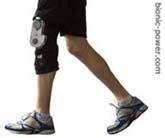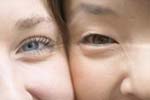VOA慢速英语 2008 0311b
搜索关注在线英语听力室公众号:tingroom,领取免费英语资料大礼包。
(单词翻译)
SCIENCE IN THE NEWS - Device Gives New Meaning to the Idea of Power Walking
Also: A common disease many people have never heard of. And scientists say people with blue eyes are genetically3 related. Transcript4 of radio broadcast:
10 March 2008
VOICE ONE:
This is SCIENCE IN THE NEWS in VOA Special English. I'm Barbara Klein.
VOICE TWO: And I'm Bob Doughty5. This week, we will tell about a device that makes electrical power from something as simple as walking. We will tell about a common disease many people have never heard of. And, we report on a study linking all blue-eyed people in the world.
And I'm Bob Doughty5. This week, we will tell about a device that makes electrical power from something as simple as walking. We will tell about a common disease many people have never heard of. And, we report on a study linking all blue-eyed people in the world.
(MUSIC)
VOICE ONE:
Electrical devices could soon use power made by human energy. Scientists say they have developed an experimental device that produces electricity from the physical movement of a person walking. A report on the device was published recently in Science magazine.
Max Donelan is an assistant professor of kinesiology at Simon Fraser University in Burnaby, British Colombia. He and other scientists in Canada and the United States developed the device.
Mister Donelan says the goal of the study was to store energy from walking in a way that can get electricity without having to increase effort.
VOICE TWO:
The device connects to a person's knee. As the person walks, the device captures energy each time the person slows down. To do this, the device assists with the slowing down movement of the leg. The movements of the person walking push parts of a small machine that produces electricity.
Using the device, an adult walking quickly could produce thirteen watts6 of electricity in just a minute. Mister Donelan says walking at that speed could produce enough power to operate a laptop computer for six minutes.
VOICE ONE:
There are several possible uses for the device. Developers say it could help people who work in areas without electricity to operate small computers or wireless7 telephones. The device could also be used to operate life-saving health devices like heart pacemakers. It could even be used to assist in the movement of robotic arms and legs.
The experimental version of the device currently weighs about one and a half kilograms. It is too costly8 for most people to buy. But the researchers hope to make a lighter9, less costly version.
Mister Donelan says an improved version should be ready in one year. The researchers also hope that soldiers could use the device. The machine could supply power to electronic devices with a battery that would re-gain power as the soldier walked.
VOICE TWO:
The developers also hope the device will one-day help developing countries. Nearly twenty-five percent of people around the world live without electric power.
A similar product was invented in two thousand five by Larry Rome of the University of Pennsylvania. He created a bag carried on a person’s back that also produces power from walking. The knee device does not produce as much electricity as the bag. But the bag requires the walker to carry a load of twenty to thirty kilograms.
(MUSIC)
VOICE ONE:
You are listening to the VOA Special English program SCIENCE IN THE NEWS. With Bob Doughty, I'm Barbara Klein in Washington.
Chronic10 obstructive pulmonary disease, or C.O.P.D., affects more than two hundred million people around the world. The World Health Organization says at least five million people died from it in two thousand five. Ninety percent were in developing countries.
In the United States, C.O.P.D. is the fourth leading cause of death. But even with these numbers, many people have never heard of it.
VOICE TWO:
The Canadian Lung Association says C.O.P.D. is the new name for emphysema and chronic bronchitis. These are the two most common forms of it. Many people with C.O.P.D. have both of them.
The result is progressive and incurable11 lung damage. The tubes that carry air in and out of the lungs become partly blocked. This makes it difficult to breathe and often produces a cough that will not go away.
People with C.O.P.D. often have swelling12 that causes the airways13 to narrow. And they often produce more mucus than normal. This oily substance protects the airways, but too much of it blocks them.
VOICE ONE:
Smoking is the most common cause of C.O.P.D. Nonsmokers can get the disease from breathing other people's tobacco smoke.
Air pollution can also cause the disease. Miners and others who work around some kinds of dust and chemicals are at higher risk. Children who repeatedly suffer lung infections have a greater chance of developing the disease as adults. Genetics may also be involved.
Doctors can perform a quick breathing test with a machine called a spirometer that can help diagnose C.O.P.D. But experts say people are often not tested or treated correctly for chronic obstructive pulmonary disease.
VOICE TWO:
Patients may not consider a continuous cough serious enough to seek medical attention. Or doctors may mistakenly identify it as asthma14 or another infection.
Some of the early warning signs are a cough that will not go away and an increase in mucus production. Another sign is difficulty breathing after minor15 activity like walking up stairs.
There are ways to slow the progress of the disease. Doctors say the most important thing is to stop smoking. There are medicines that can reduce inflammation and open air passages. Also, exercise is often advised. If the disease is severe, a doctor may order oxygen treatment or even operations to remove damaged lung tissue.
(MUSIC)
VOICE ONE:
 |
| Researchers say all humans at one time had brown eyes |
Researchers in Denmark say all human beings had brown eyes until a change in genetic2 orders produced the first blue eyes. The researchers also say people with blue eyes have a single, common ancestor. They found that blue-eyed people are genetically linked to the first person ever to have blue eyes. That person is said to have lived six thousand to ten thousand years ago.
The University of Copenhagen research team reported its findings in Human Genetics magazine.
VOICE TWO:
Team members examined genes16 of blue-eyed individuals from countries like Denmark, India, Jordan and Turkey. They found that most people with blue eyes had changed genetic orders near a gene1 called OCA Two. More than ninety nine percent of those studied had the same difference in their genetic material. Team member Hans Eiberg said they all have the same change at exactly the same place.
The researchers say the result of the changed orders is a lack of brown in the iris17 of the eye. They say the orders stop production of melanin in the eye. Melanin is a substance that gives color to eyes, skin and hair.
VOICE ONE:
The researchers say the first person with the changed genetic orders did not have blue eyes. That is because eye color results from genes passed from both the mother and the father. Blue eyes do not appear unless both parents pass the same gene for it to a child. So a child with one gene for brown eyes and one for blue will have brown eyes.
The first blue-eyed person was the product of two people with brown eyes. But they both had one brown-eyed gene and the changed gene for blue eyes. Those blue-eyed genes came together in the first person to have blue eyes.
VOICE TWO:
The Danish researchers say that person probably lived in an area northwest of the Black Sea. They say this would explain why blue eyes are mainly found in people from northern Europe and southern Russia.
The researchers say they do not yet know why the blue-eyed gene was able to survive and spread. They estimate that the changed gene is now found in about three hundred million people. And, they say that about eight percent of all the people today have blue eyes.
We leave you now with a song that Crystal Gayle made famous thirty years ago: "Don't It Make My Brown Eyes Blue."
(MUSIC)
VOICE ONE:
This SCIENCE IN THE NEWS was written by Brianna Blake and Nancy Steinbach. Our producer was Brianna Blake. I'm Barbara Klein.
VOICE TWO:
And, I'm Bob Doughty. Read and listen to our programs at voaspecialenglish.com. Join us again next week for more news about science in Special English on the Voice of America.
 收听单词发音
收听单词发音 




